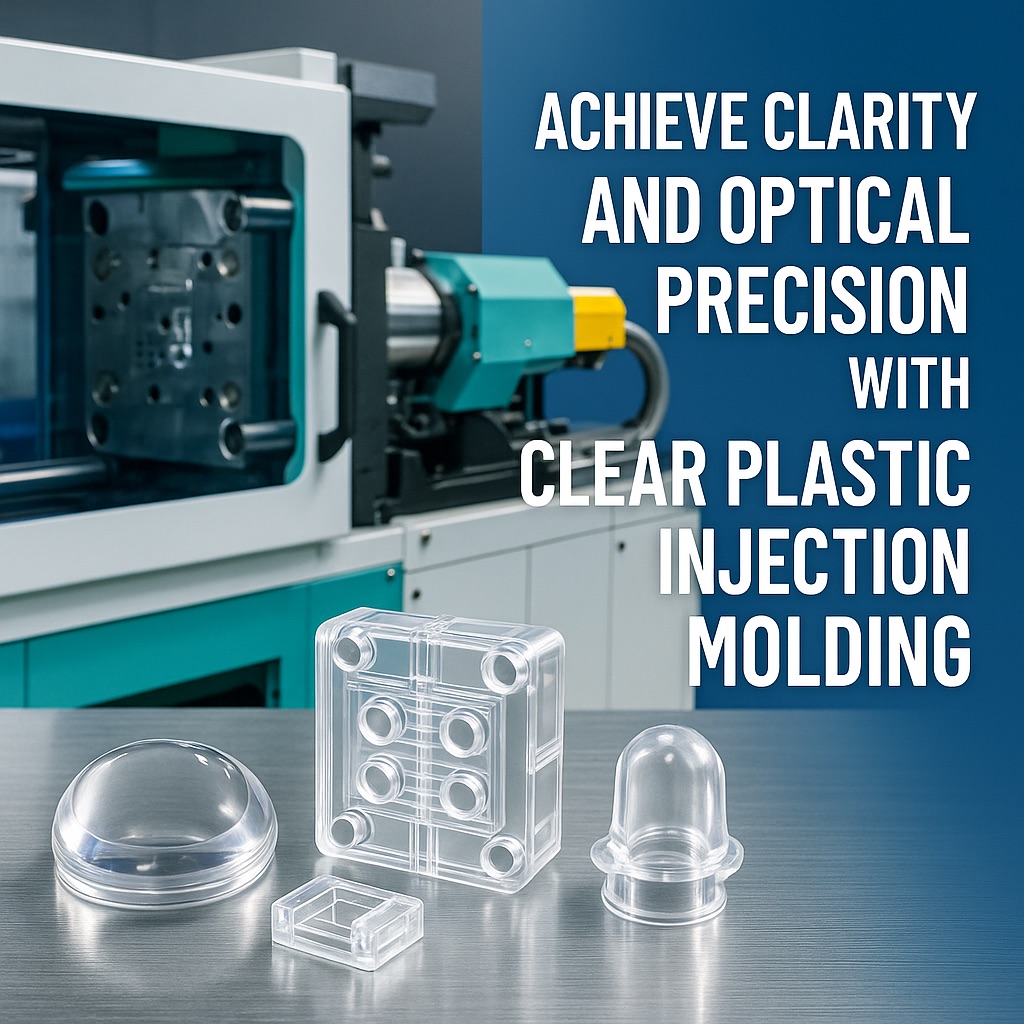Achieve Clarity & Optical Precision With Clear-Plastic Injection-Molding Techniques
Achieve Clarity & Optical Precision With Clear-Plastic Injection-Molding Techniques
From LED light pipes and automotive HUD lenses to lab-grade cuvettes, clear-plastic parts demand more than the absence of color—they require optical-grade transparency, low birefringence, and surface perfection. Below is a step-by-step playbook—design through validation—that shows how advanced molding techniques turn PC, PMMA, COC, and other transparent resins into distortion-free, crystal-clear components.
1 Choose the Right Optical Resin
| Resin | Key Advantages | Typical Limitations | Ideal Uses |
|---|---|---|---|
| PC (Optical Grade) | High impact, UL94, Gamma stable | Scratches easily; needs drying | LED lenses, safety shields |
| PMMA (Acrylic) | Highest light transmission (92 %) | Brittle in impact; low heat | Display covers, light pipes |
| COC / COP | Low birefringence, bio-inert | Costlier, lower impact | Micro-fluidic chips, cuvettes |
| PS (Crystal-Grade) | Low cost, good clarity | Poor chemical & impact | Disposable labware |
Tip – Always request melt-flow index < 10 g/10 min for tight optical tolerances.
2 Tooling Essentials for Clear Parts
-
Mirror Polish (SPI A-1 or Ra ≤ 0.02 µm)—achieved via diamond buff or vapor honing.
-
Steel Choice—S136H or NAK80 for corrosion resistance and polish retention.
-
Vent Placement—micro vents (0.005–0.01 mm) at flow ends prevent silver streaks.
-
Hot-Runner Design—valve gate with tip heaters; avoids cold slug and weld lines.
-
Conformal Cooling—keeps cavity surface ± 0.5 °C, minimizing refractive-index variation.
3 Process Window for Optical Precision
| Parameter | Target Range | Result |
|---|---|---|
| Barrel Moisture (PC) | ≤ 0.02 % | No splay or bubbles |
| Melt Temperature | PC 270 – 300 °C • PMMA 230 – 250 °C | Proper flow without yellowing |
| Mold Temp | 85 – 120 °C | High gloss & low residual stress |
| Injection Speed | Fast/consistent | Avoids flow marks, maintains optical path |
| Pack/Hold Pressure | 90 % of peak | Eliminates voids; controls birefringence |
4 Secondary Processes to Enhance Clarity
| Method | Purpose | Notes |
|---|---|---|
| Hard-Coat (Dip or UV Spray) | Scratch & UV resistance | Clean-room class 1000 recommended |
| Anti-Fog Coating | Medical & eyewear use | Plasma-activated for adhesion |
| Laser Welding | Hermetic joins without stress | One clear part, one IR-absorbing |
5 Quality-Control Toolkit
-
Haze & Light-Transmission Meter—ASTM D1003; aim for haze < 1 %.
-
Polarizing Scope—checks residual stress & birefringence rings.
-
Cavity-Pressure Sensors—correlate peak pressure with refractive-index uniformity.
-
UV-Weather-Ometer—500 h Xenon to verify ΔE < 1.0 for outdoor parts.
6 Mini-Case—Automotive HUD Combiner Lens
| Metric | First Attempt (Std PC) | Optimized Run |
|---|---|---|
| Haze | 2.8 % | 0.6 % |
| Wavefront Error | λ/3 | λ/5 |
| Scrap Rate | 4.5 % | 0.9 % |
| Hard-Coat Yield | 91 % | 98 % |
Optimization = switch to low-stress optical PC, apply conformal cooling, raise mold temp from 80 °C to 105 °C.
7 How Taiwan Mold Maker Accelerates Optical-Grade Projects
-
Ultra-polish labs—in-house diamond + nickel plating for SPI A-1 surfaces.
-
Class 7 & 8 clean-rooms with laminar enclosures over press clamp.
-
On-site hard-coat & laser-mark booths—no extra freight risk.
-
600 + stocked optical resins—PC, PMMA, COC, Trogamid, polysulfone.
???? Internal Links for One-Stop Execution
Ready for Crystal-Clear Results?
Upload your CAD & optical specifications to TaiwanMoldMaker.com for a 48-hour DFM review—including surface-finish maps, cooling simulations, and a costed timeline—to turn transparency goals into production reality.









